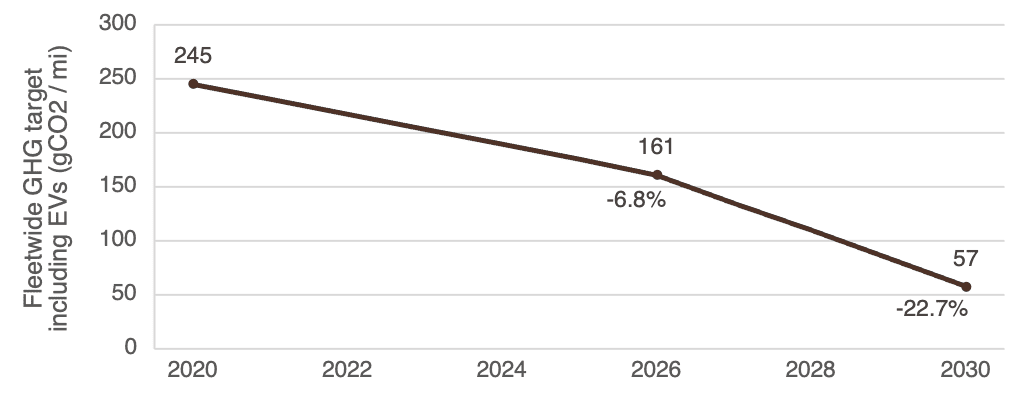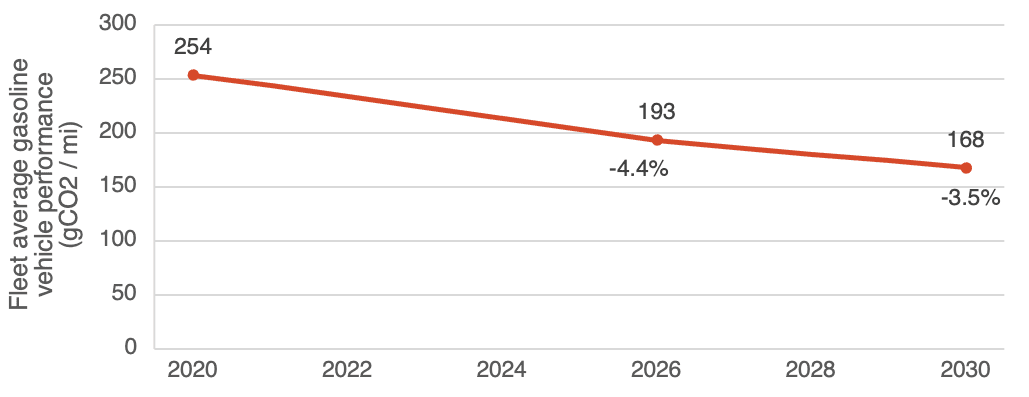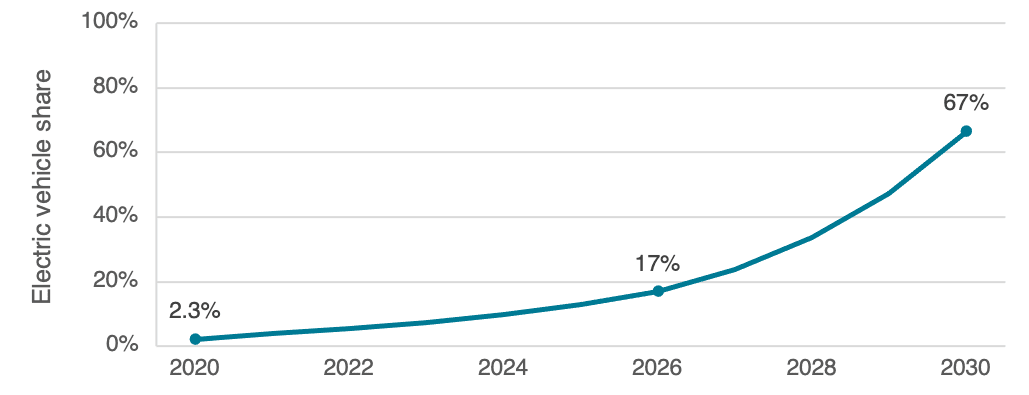Blog
Aligning the U.S. greenhouse gas standard for cars and light trucks with the Paris Climate Agreement
On his first day in office, President Biden issued an executive order for the United States to rejoin the Paris Climate Agreement. With this executive order, the U.S. joined nearly every country on earth with the shared goal of limiting global warming to well below 2 degrees Celsius. Delivering on the goals of this Agreement will require a significant reduction in greenhouse gas emissions. The transportation sector is the largest contributor to climate pollution in the United States, with light-duty vehicles—passenger cars, SUVs, and pickup trucks—account for more than half of these emissions. Therefore, a shift to zero-emission vehicles like battery electric vehicles, along with increased efficiency of new gasoline vehicles, is needed.
In a previous blog, we illustrated a path for meeting President Biden’s goal of 50% electric vehicle (EV) sales by 2030, but that’s not enough to meet the Paris commitments. The ICCT’s global modeling assessment for the Zero Emission Vehicle Transition Council shows that for the U.S. to be on a path to limiting global warming to below 2° C, at least 67% of new passenger vehicle sales will need to be plug-in electric by 2030, with the vast majority (65%) being battery electric vehicles (BEVs). That’s a lot of new electric vehicles coming from a modest baseline. In 2021, 4% of new passenger vehicle sales in the U.S. were electric, although this increased to 7% in the first 6 months of 2022. More than 75% of these new electric vehicle sales were battery-electric and the rest were plug-in hybrid. This pace will have to accelerate over the next 8 years, but with global automaker electric vehicle investments of over $1 trillion and major new federal incentives and investments such as those in the Inflation Reduction Act of 2022, the prospects of a clean mobility future are bright.
Following up on the historic Inflation Reduction Act, the most effective policy tool now in play is the next phase of the U.S. Environmental Protection Agency’s GHG emission standards for light-duty vehicles. EPA is expected to release the next phase of the rule in early 2023, which will go beyond model year 2026 to at least 2030 and can set the U.S. on a definitive decarbonization pathway. The GHG standards can be met through a combination of increasing the efficiency of gasoline vehicles and increasing EV sales. In its most recent 2021 rulemaking, EPA projected that the current standard would lead to 17% EV sales in 2026. How stringent does its 2030 standard have to be to set us on a path to 67% EV sales by 2030?
As we introduced in our previous blog, the answer to this depends on how much we expect gasoline cars and light trucks to improve. Assuming the compliance values of new gasoline vehicles improves at 3.5% per year, fleet-average gasoline emissions will decline from 193 gCO2 per mile in 2026 to 168 gCO2 per mile in 2030. To also get to 67% EV sales by 2030, the GHG standard will need to be much lower—57 gCO2 per mile by 2030.
The figure below summarizes where we need to go from the current standard of 161 gCO2 per mile in 2026 to 57 gCO2e per mile in 2030 for the whole light duty fleet (top panel). This represents a combination of continued gasoline vehicle efficiency improvements (middle panel) and accelerated EV uptake to reach 67% sales in 2030 (bottom panel), including 65% BEVs and about 2% PHEVs. This assumed composition of battery electric vs. plug-in hybrid electric vehicles is based on BEVs’ substantial economic and environmental benefits relative to PHEVs. Of course, if plug-in hybrids make up a greater share of EV sales than assessed here, then the fleetwide standards would have to be more stringent than 57 gCO2e per mile to be Paris-compatible.



Figure 1. Stringency of model year 2030 GHG targets needed to reach 67% EV sales in 2030
These targets are ambitious yet achievable. As the middle panel shows, the 3.5% annual improvement for gasoline vehicles beyond 2026 is less than the rate of improvement needed to meet the current standards through 2026. In addition, the new federal electric vehicle incentives and investments from the Inflation Reduction Act are expected to accelerate electric vehicle uptake in the United States. Efforts at the Federal level will also be helped with actions by the states. California’s new Advanced Clean Cars II regulation will lead to 68% electric vehicle sales by 2030 and 100% by 2035, and at least a dozen additional states are considering adopting California’s new rules.
Achieving a 67% electric vehicle sales share in 2030 would bring the U.S. closer to other global leaders in the EV space. Policymakers in Europe reached an agreement for a fleet average target of 0 gCO2 per mile in 2035. The United Kingdom is working toward a regulation that would require 80% of new sales to be zero-emissions by 2030, and Austria, Denmark, Greece, Iceland, Netherlands, Norway, and Slovenia have set targets for 100% zero-emission vehicle sales by 2030 or earlier.
Although reaching 57 gCO2e per mile by 2030 requires a steeper decline in GHG emissions compared to the current standards through 2026, this rate of improvement is cost-effective for combustion and battery electric vehicles alike. In addition, the associated consumer benefits grow well into the tens of billions of dollars annually by 2027 due to greatly reduced upfront electric vehicle prices and lower fuel and maintenance costs compared to fossil fuel vehicles. Anything short of a 2030 target of 57 gCO2 per mile would mean hindering widespread consumer access to these financial benefits. It would also risk the U.S. falling off the path to meeting the Paris Climate Agreement goals of limiting global warming to well below 2 degrees Celsius.
